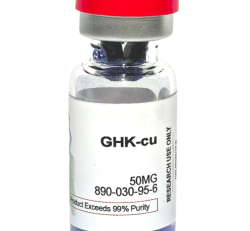Expédition
Fabricant
Description
GHK-CU:Is a peptide derived from the amino acid sequence (glycyl-histidyl-lysine) it's a naturally occurring peptide that plays a significant role in skin health, by improving skin texture, reducing the appearance of fine lines, and wrinkles, and promoting a more youthful complexion. healing, tissue regeneration commonly used in skincare products. Promoting collagen production, and angiogenesis, holds an extreme secret to promoting hair growth by stimulating hair follicles. This will lead to improved hair thickness and address hair loss concerns.
Dosage suggested: is 0.2 mL delivered subcutaneously once daily.
Peptide Storage
Best Practices For Storing Peptides
To preserve the integrity of laboratory results, proper storage of peptides is essential. Correct storage practices can maintain peptides for years and guard against contamination, oxidation, and degradation that may render your peptides, and therefore experiments, useless. While some peptides are more susceptible to degradation than others, knowing and implementing the best practices for peptide storage can greatly lengthen their stability and integrity regardless of composition.
Once peptides have been received, it is imperative that they are kept cold and away from light. If the peptides will be used immediately, or in the next several days, weeks or months, short-term refrigeration under 4C (39F) is generally acceptable. Lyophilized peptides are usually stable at room temperatures for several weeks or more, so if they will be utilized within weeks or months such storage is typically adequate.
However, for longer-term storage (several months to years) it is more preferable to store peptides in a freezer at -80C (-112F). When storing peptides for months or even years, freezing is optimal in order to preserve the peptide’s stability.
Additionally, it is important to avoid repeated freeze-thaw cycles. This can increase the peptide’s susceptibility to degradation. Also, frost-free freezers should be avoided to store peptides, as temperatures can fluctuate widely during defrosting cycles.
Storing Peptides In Solution
The shelf life of peptide solutions is far less than that of lyophilized peptides, and peptides stored in solution are also vulnerable to bacterial degradation. Peptides containing Cys, Met, Trp, Asp, Gln, and N-terminal Glu in their sequences have especially short shelf lives when in solution.
Nevertheless, suppose peptides absolutely must be stored in solution. In that case, sterile buffers at pH 5-6 should be used, and the peptide solution should be separated into aliquots to avoid repeated freezing and thawing. Peptide solutions are generally stable for up to 30 days when refrigerated at 4 °C (39°F), but those peptides with inherent instability should be kept frozen when not in use.
- Sous-total :
- 95.00
- Réduction :
- 0.00
- Taxe :
- $0.00
- Total :
- $95.00

